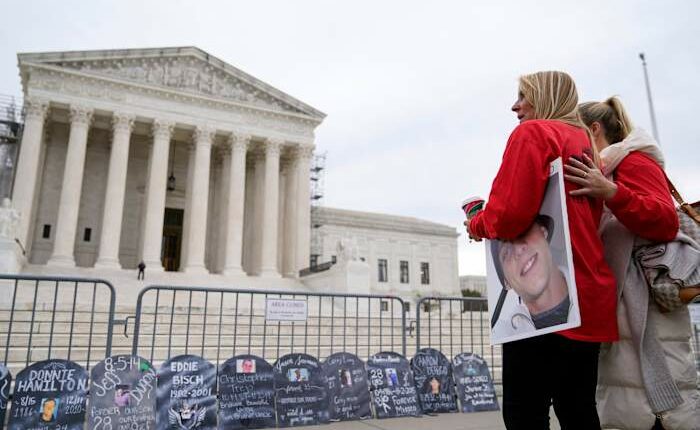Share this @internewscast.com

NEW YORK – In a pivotal moment for the ongoing legal battle over the opioid epidemic, attorneys representing Purdue Pharma, the Sackler family, and various plaintiffs, including municipalities, states, Native American tribes, and individuals affected by addiction, are set to present a unified front in bankruptcy court this Friday. Their collective aim is to urge the court to approve a settlement plan addressing thousands of opioid-related lawsuits against the pharmaceutical company.
Should U.S. Bankruptcy Judge Sean Lane consent to the proposal, it could mark the conclusion of a lengthy legal saga, potentially resolving efforts to hold Purdue Pharma accountable for its significant involvement in an opioid crisis that has claimed approximately 900,000 lives in the United States since 1999, including fatalities linked to heroin and illicit fentanyl.
The hearing, which enters its third day on Friday, is centered on closing arguments related to Purdue Pharma’s bankruptcy plan. The company sought bankruptcy protection six years ago, overwhelmed by litigation claims amounting to trillions of dollars.
Notably, this time, opposition to the settlement plan appears to be considerably subdued.
This protracted legal journey has been marked by deep emotions and heated debates among the numerous parties litigating against Purdue, often highlighting the tensions between seeking justice and navigating the complexities of bankruptcy proceedings.
Previously, the U.S. Supreme Court struck down a settlement on the grounds that it improperly granted legal immunity to Sackler family members regarding opioid-related lawsuits. Under the revised proposal, parties not participating in the settlement retain the right to sue the Sacklers. Although the family is collectively valued at billions, much of their wealth is tied up in offshore trusts, making it challenging to access through litigation.
This time, the government groups involved have reached an even fuller consensus and there’s been mostly subdued opposition from individuals. Out of more than 54,000 personal injury victims who voted on whether the plan should be accepted. just 218 said no. A larger number of people who are part of that group didn’t vote.
A handful of objectors spoke Thursday at the hearing, sometimes interrupting the judge. Some said that only the victims, not the states and other government entities, should receive the funds in the settlement. Others wanted the judge to find the members of the Sackler family criminally liable — something Lane said is beyond the scope of the bankruptcy court, but that the settlement doesn’t bar prosecutors from pursuing.
A Florida woman whose husband struggled with addiction after being given OxyContin following an accident told the court that the deal isn’t enough.
“The natural laws of karma suggest the Sacklers and Purdue Pharma should pay for what they have done,” Pamela Bartz Halaschak said via video.
Deal would be among the biggest opioid settlements
A flood of lawsuits filed by government entities against Purdue and other drugmakers, drug wholesalers and pharmacy chains began about a decade ago.
Most of the major ones have already settled for a total of about $50 billion, with most of the money going to fight the opioid crisis.
The Purdue deal would rank among the largest of them. Members of the Sackler family would be required to pay up to $7 billion and give up ownership of the company. None have been on its board or received payments since 2018. Unlike a similar hearing four years ago, none were called to testify in this week’s hearing.
The company would get a name change and new overseers who would dedicate future profits to battling the opioid crisis.
There are also some non-financial provisions. Certain members of the Sackler family would be required to give up involvement in companies that sell opioids in other countries.
Family members would also be barred from having their names added to institutions in exchange for charitable contributions. The name has already been removed from museums and universities.
And company documents, including many that would normally be subject to lawyer-client privilege, are to be made public.
Some people hurt by Purdue’s opioids would receive some money
Unlike the other major opioid settlements, individuals harmed by Purdue’s products would be in line for some money as part of the settlement. About $850 million would be set aside for them, with more than $100 million of that amount carved out to help children born dealing with opioid withdrawal.
About 139,000 people have active claims for the money. Many of them, however, have not shown proof that they were prescribed Purdue’s opioids and will receive nothing. Lawyers expect that those who had prescriptions for at least six months would receive about $16,000 each and those who had them more briefly would get around $8,000. Legal fees would reduce what people actually receive.
One woman who had a family member suffer from opioid addiction told the court by video Thursday that the settlement doesn’t help people with substance use disorder.
“Tell me how you guys can sleep at night knowing people are going to get so little money they can’t do anything with it,” asked Laureen Ferrante of Staten Island, New York.
Most of the money is to go to state and local governments to be used in their efforts to mitigate damage of the opioid epidemic. Overdose death numbers have been dropping in the past few years, a decline experts believe is partly due to the impact of settlement dollars.
Copyright 2025 The Associated Press. All rights reserved. This material may not be published, broadcast, rewritten or redistributed without permission.












